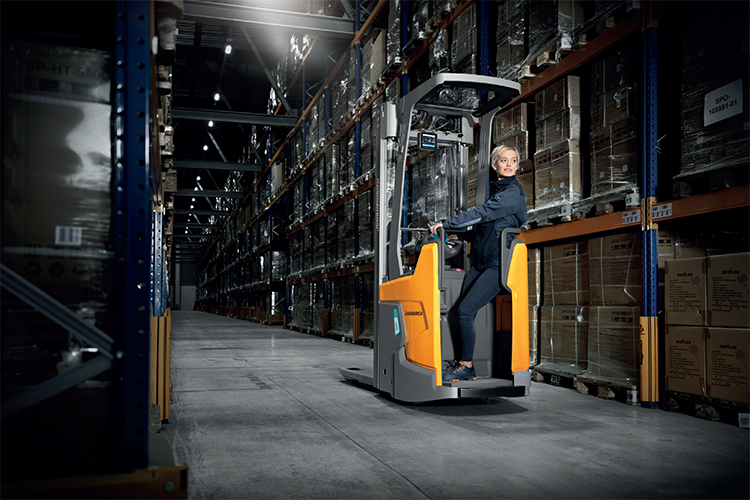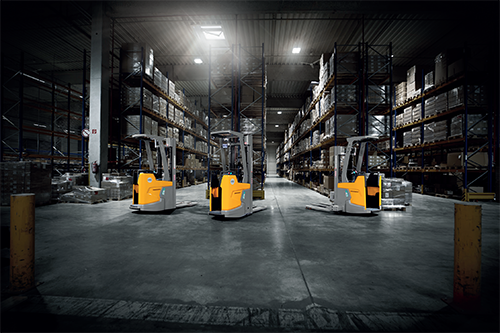
Leaner, greener, and meaner
‘Sustainability’ is high on the media and business agenda, having firmly rooted itself in the minds and strategies of businesses worldwide. Sustainable logistics in the supply chain can be defined simply as optimizing business risk, environmental considerations, and waste cost by examining various parts of a logistics network. Businesses are increasingly focusing on being more sustainable – especially in addressing environmental concerns, but what steps can they take to simultaneously meet these requirements while also reaping economic benefits?
The sustainable journey begins
Three elements to consider when it comes to sustainability within supply chains are social, economic and environmental. However, in the warehouse, businesses often start with addressing the economic and environmental factors as a priority.
The environmental pillar often gets the most attention with government pressure higher than ever on companies to reduce their carbon footprints, electrical or water usage and their overall impact on the environment. For example, the removal of the Red Diesel business entitlement in 2022 means that many companies will need to quickly overhaul their diesel equipment and consider more energy efficient power alternatives.
While investing in environmental CSR efforts may appear to be a logistical burden, these efforts may also unlock significant financial benefits for those companies that invest in them. Companies that invest in their environmental CSR initiatives also find that doing so can also lead to significant financial gains. For example, businesses that use lithium-ion batteries for materials handling equipment have found that having a beneficial impact on the environment can also lead to financial gain.
The economic pillar provides a counterweight to challenging measures that corporations are pushed to adopt, such as abandoning fossil fuels rather than phasing in changes. In today’s robust competitive industry and turbulent economic environment, most factories need to readjust their strategy to produce as many products as possible at a minimal cost. The goal is to make the production process more efficient, productive and ultimately – sustainable. So, what remedies can businesses take to improve not just their environmental credentials, but also their bottom line?
 The catalyst for automation
The catalyst for automation
Pre-pandemic, the concept of innovating to survive was for some businesses not a core focus. Although Covid-19 and the global economic shutdown that followed have accelerated the need for smooth, seamless operations, companies are also ensuring that they are prepared for any disruptive events that might occur in the future. Due to lockdowns, social distancing, combined with changing consumer habits such as the rise of ecommerce, today’s warehouses must now look to find ways to operate effortlessly and economically while adhering to new post-pandemic health and safety protocols.
The reality of Covid-19 and its impact on the warehouse and supply chain management industry has uncovered gaps and inefficiencies in supply chain and warehouse automation strategy. But these types of hurdles have served as the catalyst for warehouse managers to adopt and implement automation technology, to shift and adapt to peaks in demand and the need for efficiency.
The automation of warehouses drives value, but while robots may assist warehouse workers for the most mundane tasks, such as picking, packing, and transporting, they will never be able to take over for human workers on more intricate tasks, such as repairing and analyzing. This will not only provide ROI and continuity during a crisis like the current pandemic, but in the long-term to meet long-lasting business goals as well.
Pre-pandemic, automation was viewed as a luxury; now it’s a necessity. With the booming e-commerce intralogistics market, warehouse managers can’t afford to let productivity slide. They need to have a strategy that involves automation to create leaner, greener and more streamlined operations while continuing to contribute to sustainability.
Reduce, Reuse, Recycle
Lithium-ion is at the forefront of the electric transport and energy storage revolution. Businesses already using lithium-ion can continue to demonstrate and grow their environmental credentials through productivity and efficiency gains. As with all batteries, those from electric vehicles are eventually destined for recycling.
The energy storage market is growing dramatically. As we see storage becoming increasingly competitive and common, its applications and business cases will diversify which bodes well for opportunities for second-life battery systems.
The environmental footprint created by the manufacture of lithium-ion batteries, in terms of metals extraction and energy needed in production, can be greatly reduced by deploying them in secondary market applications, such as wall chargers that use second-life batteries to supplement grid supply. Especially with lithium-ion it allows the opportunity to charge for a longer lifetime, with higher energy density thus increasing the lifespan of the equipment and contributing to the companies sustainability targets.
The European Commission acknowledges that batteries will play a fundamental role in delivering the EU’s 2050 net-zero ambition, which will be delivered through the Green Deal policy. Driven by transport demand as well as by industrial uses, the EU is forecast to account for 17 percent of global lithium-ion battery demand by 2030, making it the second-biggest market globally.
However, to ensure a competitive and sustainable industry, businesses should encourage reuse, improving batteries collection and recycling of materials. By ensuring that a level playing field exists across all battery products, processes, and waste batteries, the Green Deal Policy is supposed to improve the functioning of the internal battery market, promote a circular economy, and reduce environmental and social impacts at every stage of the battery life cycle.
Conclusion
Companies are facing numerous obstacles with the intensification of globalization, including increasing global competition, increasing consumer demands and expectations, rising personnel costs, and increasing environmental regulations. Additionally, companies are using environmental, social, and economic perspectives in their strategy planning and execution to explore environmentally friendly and efficient means of addressing challenges that will further maximize their business landscapes in an all-round sustainable manner.
 Alexander Baal is Director of Sales Operations at Jungheinrich in the UK. Founded in 1953, Jungheinrich ranks among the world’s leading solutions providers for the intralogistics sector. With a comprehensive portfolio of material handling equipment, automatic systems and services, Jungheinrich is able to offer customers tailored solutions for the challenges posed by Industry 4.0. The Hamburg-based Group is represented worldwide in 40 countries with its own direct sales companies and in approximately 80 other countries through partner companies. Jungheinrich is listed on the MDAX.
Alexander Baal is Director of Sales Operations at Jungheinrich in the UK. Founded in 1953, Jungheinrich ranks among the world’s leading solutions providers for the intralogistics sector. With a comprehensive portfolio of material handling equipment, automatic systems and services, Jungheinrich is able to offer customers tailored solutions for the challenges posed by Industry 4.0. The Hamburg-based Group is represented worldwide in 40 countries with its own direct sales companies and in approximately 80 other countries through partner companies. Jungheinrich is listed on the MDAX.
www.jungheinrich.com/en